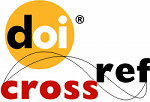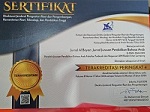Hedges in English and Arabic Metadiscourse Utility in Academic Writing: A Contrastive Analysis
Abstract
Keywords
Full Text:
PDFReferences
Al-Moreno. “Genre Constraints across Languages: Causal Metatext in Spanish and English RAs.” English for Specific Purposes 16, no. 3 (1997): 161–179. https://doi.org/10.1016/S0889-4906(96)00023-3.
Al-Ghoweri, Helen A., and Murad M. Al Kayed. “A Comparative Study of Hedges and Boosters in English and Jordanian Arabic: Economic Newspaper Articles as a Case Study.” Theory and Practice in Language Studies 9, no. 1 (2019): 52–59. http://dx.doi.org/10.17507/tpls.0901.08.
Al-Saleemi, Elham. “A Contrastive Study of the Verb Systems of English and Arabic.” Durham University, 1987.
Aldahesh, Ali Yunis. “On Idiomaticity in English and Arabic: A Cross - Linguistic Study.” Journal of Languages and Culture 4, no. 2 (2013): 23–29. https://doi.org/ 10.5897/JLC2013.0220.
Ashour, Hadeel Mohammad. “Major Differences Between Arabic and English Pronunciation Systems: A Contrastive Analysis Study.” AL-Lisan International Journal for Linguistic & Literary Studies 1, no. 1 (2017): 132–150.
Aziz, R A. “The Use of Interactional Metadiscourse in the Construction of Gender Identities among Malaysian ESL Learners.” 3L: Language, Linguistics, Literature 22, no. 1 (2016): 207–220.
Bal-Gezegin, B. “Metadiscourse in Academic Writing: A Comparison of Research Articles and Book Reviews.” Eurasian Journal of Applied Linguistics 6 no. 1 (2020): 45-62. http://dx.doi.org/10.32601/ejal.710204.
Beauvais, Paul J. “A Speech Act Theory of Metadiscourse.” Written Communication1 6, no. 1 (1989): 11–30.
Crismore, Avon. “The Rhetoric of Textbooks: Metadiscourse.” Journal of Curriculum Studies 16, no. 3 (1984): 279–296.
Crismore, Avon, Raija Markkanen, and Margaret S. Steffensen. “Metadiscourse in Persuasive Writing: A Study of Texts Written by American and Finnish University Students.” Written Communication 10, no. 1 (1993): 39–71. https://doi.org/10.1177/0741088393010001002.
Deng, Liming, Bagheri Fatemeh, and Xiaoping Gao. “Exploring the Interactive and Interactional Metadiscourse in Doctoral Dissertation Writing: A Diachronic Study.” Scientometrics 126, no. 8 (2021): 7223–7250. https://doi.org/10.1007/s11192-021-04064-0.
El-Seidi, Maha. “Metadiscourse in English and Arabic Argumentative Writing: A Cross-Linguistic Study of Texts Written by American and Egyptian University Students.” In Diversity in Language: Contrastive Studies in Arabic and English Theoretical and Applied Linguistics, edited by Zeinab M. Ibrahim, Sabiha T. Aydelott, and Nagwa Kassabgy, 111–126. New York: The American University in Cairo Press, 2000.
Ghahremani Mina, Khadije, and Reza Biria. “Exploring Interactive and Interactional Metadiscourse Markers in Discussion Sections of Social and Medical Science Articles.” International Journal of Research in English Education 2, no. 4 (2017): 11–29.
Hafizah Anwardeen, Nor, Eunice Ong Luyee, Joanna Indra Gabriel, and Seyed Ali Rezvani Kalajahi. “An Analysis: The Usage of Metadiscourse in Argumentative Writing by Malaysian Tertiary Level of Students.” English Language Teaching 6, no. 9 (2013): 83–96.
Hamdallah, Rami, and Hanna Tushyeh. "A Contrastive Analysis of Selected English and Arabic Prepositions with Pedagogical Implications." Papers and Studies in Contrastive Linguistics 28 no. 2 (1993): 181-190.
Hyland, Ken. “Talking to Students: Metadiscourse in Introductory Coursebooks.” English for Specific Purposes 18, no. 1 (1999): 3–26.
Hyland, Ken, and Polly Tse. “Metadiscourse in Academic Writing: A Reappraisal.” Applied Linguistics 25, no. 2 (June 2004): 156–177. https://doi.org/10.1093/applin/25.2.156.
Kan, M. “The Use of Interactional Metadiscourse: A Comparison of Articles on Turkish Education and Literature.” Kuram ve Uygulamada Egitim Bilimleri 16, no. 5 (2016): 1639–1648.
Kashiha, Hadi, and Susan Marandi. “Rhetoric-Specific Features of Interactive Metadiscourse in Introduction Moves: A Case of Discipline Awareness.” Southern African Linguistics and Applied Language Studies 37, no. 1 (January 2019): 1–14.
Ken Hyland. Metadiscourse: Exploring Interaction in Writing. London: Bloomsbury Publishing, 2018.
Krzeszowski, Tomasz P. “Quantitative Contrastive Analysis.” Studia Linguistica 35, no. 1–2 (1981): 102–113.
Lardiere, Donna. “Some Thoughts on the Contrastive Analysis of Features in Second Language Acquisition.” Second Language Research 25, no. 2 (2009): 173–227.
Liu, C. “Paradigmatic Variation in Hedging and Boosting: A Comparative Study of Discussions in Narrative Inquiry and Grounded Theory Research.” English for Specific Purposes 61 (2021): 1–16.
Mirshamsi, A, and H Allami. “Metadiscourse Markers in the Discussion/Conclusion Section of Persian and English Master’s Theses.” The Journal of Teaching Language Skills 5, no. 3 (2013): 23–40.
Mur-Dueñas. “An Intercultural Analysis of Metadiscourse Features in Research Articles Written in English and in Spanish.” Elsevier 43 (2011): 3068–3079.
Mur-Dueñas, Pilar. “An Intercultural Analysis of Metadiscourse Features in Research Articles Written in English and in Spanish.” Journal of Pragmatics 43, no. 12 (2011): 3068–3079.
Oller, John W., and Seid M. Ziahosseiny. “The Contrastive Analysis Hypothesis and Spelling Errors.” Language Learning 20, no. 2 (1970): 183–189.
Paltridge, Brian. “Metadiscourse: Exploring Interaction in Writing. .” Journal of Pragmatics 39, no. 1 (January 2007): 226–227.
Peng, J E. “Metadiscourse and Voice Construction in Discussion Sections in BA Theses by Chinese University Students Majoring in English.” SAGE Open 11, no. 2 (2021).
Shahid, Muhammad Imtiyaz, Hafiz Muhammad Qasim, and Muhammad Hasnain. “A Cross-Linguistic Study of Metadiscourse in English and Urdu Newspaper Editorials.” Corporum: Journal of Corpus Linguistics 3, no. 1 (2020): 33–56.
Sheikholeslami, Cynthia May, and Nabila el-Taher Makhlouf. “The Impact of Arabic on ESL Expository Writing.” In Diversity in Language: Contrastive Studies in Arabic and English Theoretical and Applied Linguistics, edited by Zeinab M. Ibrahim, Sabiha T. Aydelott, and Nagwa Kassabgy. New York: The American University in Cairo Press, 2000.
Spolsky, Bernard. “Contrastive Analysis, Error Analysis, Interlanguage, and Other Useful Fads.” The Modern Language Journal 63, no. 5–6 (1979): 250–257.
Studies, R Abdi - Discourse, and undefined 2002. “Interpersonal Metadiscourse: An Indicator of Interaction and Identity.” journals.sagepub.com 4, no. 2 (2002): 139–145.
Sultan, Abbas. “A Contrastive Study of Metadiscourse in English and Arabic Linguistics Research Articles.” Acta Linguistica 5, no. 1 (2011): 28–4.
Tang, Kok-Sing. “The Interconnections among Metadiscourse, Metalanguage, and Metacognition: Manifestation and Application in Classroom Discourse.” Linguistics and Education 65 (2021).
Taqi, Jumanah Shakeeb Muhammad. “Hedges in English and Arabic: A Contrastive Study.” İlköğretim Online - Elementary Education Online 20, no. 3 (2021): 604–614.
Thyab, R. A. “Mother-Tongue Interference in the Acquisition of English Articles by L1 Arabic Students.” Journal of Education and Practice 7, no. 3 (2016): 1–4.
Wang, Y. The Idiom Principle and L1 Influence: A Contrastive Learner-Corpus Study of Delexical Verb+ Noun Collocations. Amsterdam: John Benjamins Publishing Company, 2016.
Whitman, Randal L. “Contrastive Analysis: Problems and Procedures.” Language Learning 20, no. 2 (1970): 191–197.
Wyatt, James L. “Contrastive Analysis Via the Chomskyan Verb Phrase Formula.” Language Learning 16, no. 1–2 (1966): 41–48.
Yoon, H J. “Interactions in EFL Argumentative Writing: Effects of Topic, L1 Background, and L2 Proficiency on Interactional Metadiscourse.” Reading and Writing 34, no. 3 (2021): 705–725.
Zakaria, M K. “Metadiscourse in the Academic Writing of Local and International Students at a University in Malaysia.” International Journal of Education and Practice 6, no. 4 (2018): 227–238. https://doi.org//10.18488/journal.61.2018.64.227.238.
DOI: http://dx.doi.org/10.24042/albayan.v14i2.12144
Refbacks
- There are currently no refbacks.
Copyright (c) 2022 Jurnal Al Bayan: Jurnal Jurusan Pendidikan Bahasa Arab
License URL: https://creativecommons.org/licenses/by-nc-sa/4.0
Editorial Office:
Jurnal Al Bayan: Jurnal Jurusan Pendidikan Bahasa Arab, Arabic Education Study Program, Faculty of Education and Teachers Training, Unversitas Islam Negeri Raden Intan Lampung
Jl. Endro Suratmin 1 Sukarame, Bandar Lampung 35131-Indonesia
e-mail: jurnalalbayan@radenintan.ac.id
http://ejournal.radenintan.ac.id/index.php/albayan/index
Jurnal Al Bayan: Jurnal Jurusan Pendidikan Bahasa Arab is licensed under a Creative Commons Attribution-ShareAlike 4.0 International License. p-ISSN 2086-9282 | e-ISSN 2549-1229









